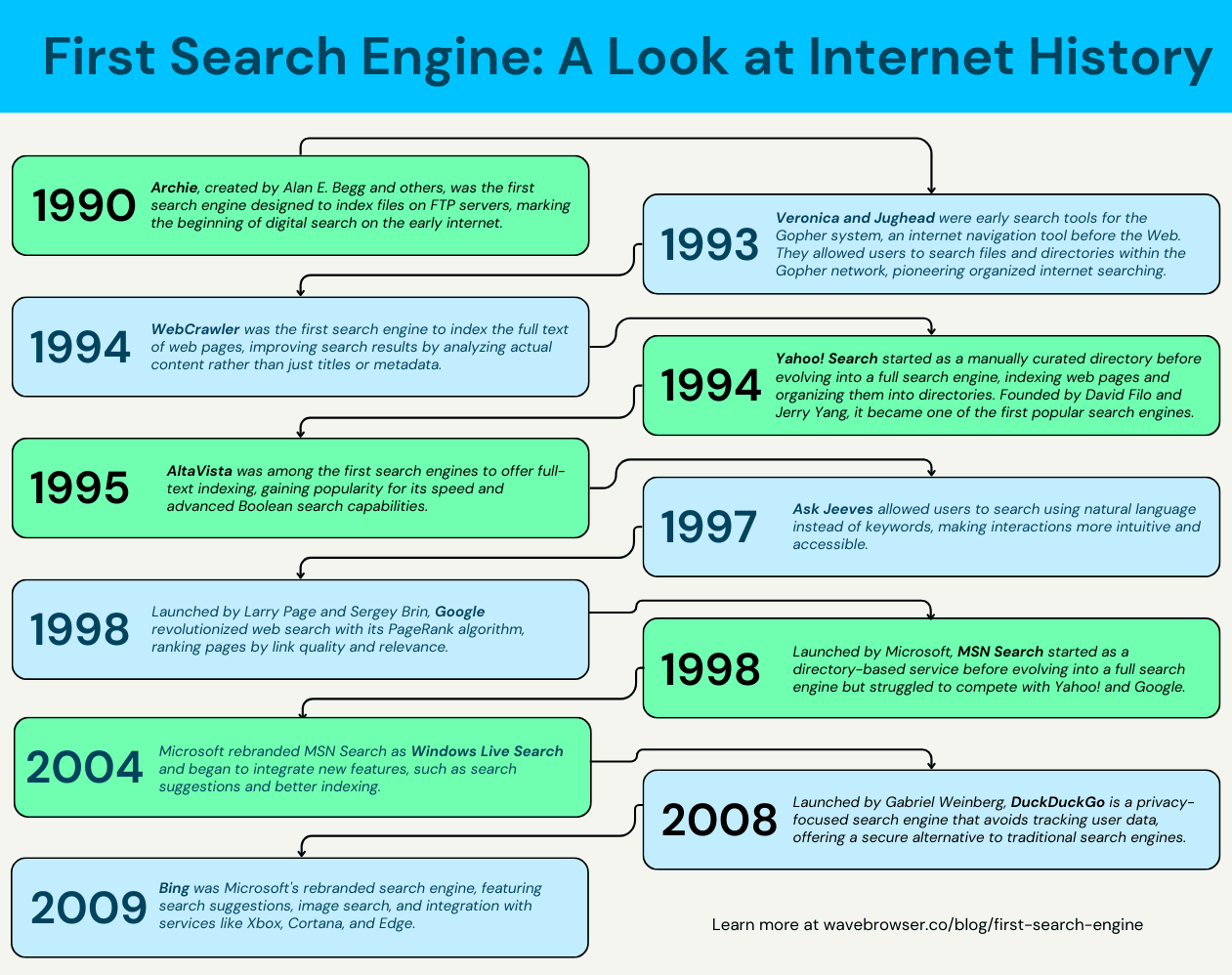
The World Wide Web as we know it today relies on powerful search engines to help users find information instantly. But before Google and Bing dominated the internet, the first search engine paved the way for modern search technology.
In this article, we’ll explore the origins of the first search engine, how it worked, and its role in shaping the way we navigate the World Wide Web today.
What Is The Oldest Internet Search Engine?
The oldest internet search engine is Archie, created in 1990 by Alan Emtage, a student at McGill University in Canada. Emtage developed Archie, the first search engine, as a tool to automate the process of indexing file directories, allowing users to search for specific files efficiently.
Archie, short for "archive" without the "v," was not a full-fledged web search engine as we know them today. Instead, it worked by periodically downloading directory listings from public FTP servers, storing them in a searchable database. Users could then search these listings using simple queries, making it easier to find downloadable files.
This innovation marked a key moment in the history of search engines, laying the foundation for later advancements. By the mid-1990s, search engines like Veronica, Jughead, and later AltaVista expanded on Archie's concept, indexing actual web pages instead of just file directories. Eventually, this evolution led to the powerful, algorithm-driven search engines we rely on today, such as Google and Bing.
Is Archie Still a Search Engine?
No, Archie Search Engine is no longer active in the way modern search engines operate. However, its legacy remains significant as the first tool designed to index and retrieve files from the internet.
When Did The Internet Go Public?
The internet became publicly accessible on April 30, 1993, when CERN (the European Organization for Nuclear Research) released the World Wide Web into the public domain. This decision, led by Tim Berners-Lee, allowed anyone to use the technology freely, which contributed to the rapid growth of the web.
However, the history of the internet dates back much earlier. The foundation of the modern internet was laid in 1969 with the creation of ARPANET, a network developed by the U.S. Department of Defense's Advanced Research Projects Agency (ARPA). Over the following decades, advancements in networking protocols (like TCP/IP in 1983) helped shape the internet into what it is today.
By the early 1990s, with the introduction of web browsers and search engines, the internet became more user-friendly, leading to its explosion in popularity.
What Is The World Wide Web Wanderer?
The World Wide Web Wanderer (also known as Wanderer) was one of the first web crawlers, created in 1993 by Matthew Gray, a computer science student at the Massachusetts Institute of Technology (MIT). The main purpose of Wanderer was to measure the size of the World Wide Web by gathering data on the number of websites and web servers.
Wanderer was essentially a program that "wandered" the web, following hyperlinks and indexing websites. This project laid the groundwork for future web crawlers and search engines, but it was not designed to index content for search engines. Instead, it was mainly used for research purposes to track the rapid growth of the web.
Wanderer also had the distinction of being one of the first programs to be labeled as a "web robot" or "spider." The data it collected helped researchers understand the early structure of the World Wide Web.
The First Search Engine Timeline

Over the years, the search market has undergone significant transformations, driven by technological advancements and changing user needs. From the early days of indexing simple file directories to the sophisticated algorithms of today, the largest search engines have continuously improved to handle complex search queries more efficiently.
One of the most notable developments in recent years has been the integration of artificial intelligence into search engine results. AI technologies, such as machine learning and natural language processing, have enhanced search accuracy and information retrieval, allowing engines to better understand user intent and deliver more relevant results.
Explore the timeline, from the first search engine to the modern ones.
1. The Origins of Search Engines: Archie (1990)
Archie, the first search engine created by Alan E. Begg and others, was designed to index files stored on FTP servers. While it wasn’t a search engine for web pages, it was the first attempt to organize and locate files on the early internet, marking the start of digital search.
2. Veronica and Jughead: Search Tools for Gopher (1993)
Veronica and Jughead were early search tools created for the Gopher system, which was an internet navigation tool before the rise of the World Wide Web. These tools helped users search for files and directories within the Gopher network, offering a glimpse into how organized searching could work on the internet.
3. WebCrawler: A Breakthrough in Full-Text Search (1994)
WebCrawler became the first search engine to index the full text of web pages, not just the title or metadata. This innovation made it easier for users to find relevant content across the growing web, providing search results based on the actual content of a page rather than just directories or file names.
4. Yahoo! and the Shift from Directory to Search Engine (1994)
Initially a manually curated directory of websites, Yahoo! Search evolved into a full-fledged search engine in 1994. It began indexing web pages and categorizing them into directories, which made it one of the first popular tools for navigating the internet. Yahoo! was founded by David Filo and Jerry Yang, who were pivotal to its development.
In 2004, Yahoo! acquired Inktomi, a search engine technology provider, and integrated it into its search platform. This partnership marked a significant shift in how Yahoo! approached search. Eventually, Yahoo! moved to using Google’s search algorithm to power its search results, further cementing Google’s position as the dominant search engine.
5. AltaVista: A Pioneer in Speed and Search Technology (1995)
AltaVista, launched in 1995, was one of the first search engines to offer full-text indexing of web pages. Its speed and search capabilities, including advanced Boolean search options, made it a favorite among internet users and a major player in search technology at the time.
6. Ask Jeeves: Natural Language Search (1997)
Ask Jeeves introduced a unique feature by allowing users to ask questions in natural language rather than relying on keyword-based queries. This conversational approach to search helped people interact with search engines in a way that felt more intuitive, making it easier to find information using everyday language.
7. Google: The Search Engine That Changed Everything (1998)
Launched in 1998 by Larry Page and Sergey Brin while studying at Stanford University, Google Search Engine redefined how we navigate the web. With its PageRank algorithm, Google ranked pages based on the quality and quantity of links pointing to them, ensuring that users received the most relevant results.
In 2000, Google introduced AdWords, a pay-per-click advertising system that transformed digital marketing. Google also revolutionized the search experience with innovations like Google Instant (2010) and the Knowledge Graph (2012), which offered real-time results and contextually relevant information.
In 2015, RankBrain, an AI-powered algorithm, improved search accuracy by understanding the intent behind queries, marking a significant leap towards AI-driven search. Today, Google is the most popular search engine and leads the way in search with advanced AI and machine learning algorithms, providing users with highly relevant, personalized search results.
Besides that, Google shaped Search Engine Optimization (SEO) by focusing on delivering better results for users, ensuring that websites ranking at the top of the search results were those that offered the most relevant, high-quality content, which ultimately led to greater user satisfaction.
8. MSN Search: Microsoft's First Bet (1998)
MSN Search was a search engine launched by Microsoft in 1998. It was initially a directory-based search service that later evolved into a full-fledged search engine. MSN Search struggled to gain significant market share in its early years, competing against other search engines like Yahoo! and Google.
In 2004, Microsoft rebranded MSN Search as Windows Live Search and began to integrate new features, such as search suggestions and better indexing. In 2009, the search engine was rebranded again, this time as Bing.
9. DuckDuckGo: Focused on Online Privacy (2008)
DuckDuckGo, launched in 2008, was developed by Gabriel Weinberg, an MIT graduate who studied Management Science and Engineering. DuckDuckGo is currently the best search engine for privacy and has gained attention for its focus on protecting personal data. It offers an alternative to traditional search engines by ensuring that user data and activities are not tracked.
10. Bing: Microsoft’s Entry into the Search Engine Market (2009)
Microsoft launched Bing in 2009, aiming to compete with Google by offering a more intuitive and feature-rich search experience. Bing introduced features like related searches, instant answers, and a visually appealing interface. While it has not overtaken Google in global market share, Bing has remained a key player in the search engine landscape, continually evolving its features to provide users with improved search results.
The evolution of search engines has played a pivotal role in shaping the way we navigate the internet today. As we look at how these engines have evolved, it’s essential to recognize their close relationship with web browsers.
Browsers such as Internet Explorer, Google Chrome, and Microsoft Edge have integrated search functionality to provide a seamless browsing experience. They have become essential tools for users to access and interact with search engines, bridging the gap between information and the user. The partnership between search engines and browsers continues to shape our online behavior, influencing not just the way we search but how we experience the web as a whole.
